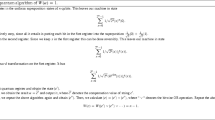Abstract
In this paper we present two algorithms for reducing systems of multivariate polynomial equations over the finite field F 2 to the canonical triangular form called lexicographical Gröbner basis. This triangular form is the most appropriate for finding solutions of the system. On the other hand, the system of polynomials over F 2 whose variables also take values in F 2 (Boolean polynomials) completely describes the unitary matrix generated by a quantum circuit. In particular, the matrix itself can be computed by counting the number of solutions (roots) of the associated polynomial system. Thereby, efficient construction of the lexicographical Gröbner bases over F 2 associated with quantum circuits gives a method for computing their circuit matrices that is alternative to the direct numerical method based on linear algebra. We compare our implementation of both algorithms with some other software packages available for computing Gröbner bases over F 2.
Similar content being viewed by others
References
C. M. Dawson, H. L. Haselgrove, A. P. Hines, D. Mortimer, M. A. Nielsen, and T. J. Osborne, “Quantum Computing and Polynomial Equations over the Finite Field Z 2,” arXiv:quant-ph/0408129.
V. P. Gerdt, R. Kragler, and A. N. Prokopenya, “A Mathematica Package for Construction of Circuit Matrices in Quantum Computation,” Computer Algebra and Differential Equations. Acta Acad. Aboensis 67(2), 28–38 (2007).
V. P. Gerdt, R. Kragler, and A. N. Prokopenya, A Mathematica Package for Construction of Circuit Matrices in Quantum Computation,” Phys. Part. Nucl. Lett. 6(7), (2009, in press).
D. Aharonov, “A Simple Proof that Toffoli and Hadamard Gates are Quantum Universal,” arXiv:quantph/0301040.
M. Nielsen and I. Chuang, Quantum Computation and Quantum Information (Cambridge Univ. Press, Cambridge, 2000).
C. M. Dawson and M. A. Nielsen, “The Solovay-Kitaev Algorithm,” arXiv:quant-ph/0505030.
A. B. Nagy, “On an Implementation of the Solovay-Kitaev Algorithm,” arXiv:quant-ph/0606077.
A. Y. Kitaev, A. H. Shen, and M. N. Vyalyi, Classical and Quantum Computation, vol. 47 of Graduate Studies in Mathematics (Amer. Math. Soc., Providence, Rhode Island, 2002).
V. P. Gerdt and V. M. Severyanov, “A C# Package for Assembling Quantum Circuits and Generating Associated Polynomial Sets,” Phys. Part. Nucl. Lett. 4, 225 (2007).
B. Buchberger, “Gröbner Bases: An Algorithmic Method in Polynomial Ideal Theory,” in Recent Trends in Multidimensional System Theory, Ed. by N. K. Bose (Reidel, Dordrecht, 1985), pp. 184–232.
B. Buchberger and F. Winkler (Eds.) Gröbner Bases and Applications. (Cambridge Univ. Press, Cambridge, 1998).
V. P. Gerdt and Yu. A. Blinkov, “Involutive Bases of Polynomial Ideals,” Math. Comp. Simulat. 45, 519–542 (1998); arXiv:math.AC/9912027; “Minimal Involutive Bases,” Math. Comp. Simulat. 45, 543–560 (1998); arXiv:math.AC/9912029.
V. P. Gerdt, “Involutive Algorithms for Computing Gröbner Bases,” in Computational Commutative and Non-Commutative Algebraic Geometry, Ed. by S. Cojocaru, G. Pfister and V. Ufnarovski, NATO Sci. Ser. (IOS Press, 2005), pp. 199–225; arXiv:math.AC/0501111.
A. Giovinni, T. Mora, G. Niesi, L. Robbiano, and C. Traverso, “One Sugar Cube, Please, or Selection Strategies in the Buchberger Algorithm,” in Proc. of ISSAC’91 (ACM Press, 1991), pp. 49–54.
V. P. Gerdt and M. V. Zinin, “On Computation of Bases Over F 2,” Comp. Algebra Diff. Equat. Acta Acad. Aboensis B 67(2), 59–68 (2007).
G.-M. Greuel, G. Pfister, and H. Schonemann, Singular 3.0 A Computer Algebra System for Polynomial Computations (Centre for Computer Algebra, Univ. Kaiserslautern, 2005); http://www.singular.uni-kl.de.
http://www-sop.inria.fr/saga/POL; http://www.math.uic.edu~jan/demo.html
V. V. Kornyak, On Compatibility of Discrete Relations, LNC 3718 (Springer-Verlag, 2005), pp. 272–284; arXiv:math-ph/0504048.
V. P. Gerdt and Yu. A. Blinkov, “Specialized Computer Algebra System GINV,” Program. Comp. Software 34, (2008); http://invo.jinr.ru/
Author information
Authors and Affiliations
Corresponding author
Additional information
The article is published in the original.
The research presented in this paper was partially supported by grant 07-01-00660 from the Russian Foundation for Basic Research and by grant 5362.2006.2 from the Ministry of Education and Science of the Russian Federation.
Rights and permissions
About this article
Cite this article
Gerdt, V.P., Zinin, M.V. An algorithmic approach to solving polynomial equations associated with quantum circuits. Phys. Part. Nuclei Lett. 6, 521–525 (2009). https://doi.org/10.1134/S154747710907005X
Published:
Issue Date:
DOI: https://doi.org/10.1134/S154747710907005X




